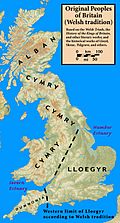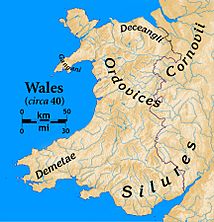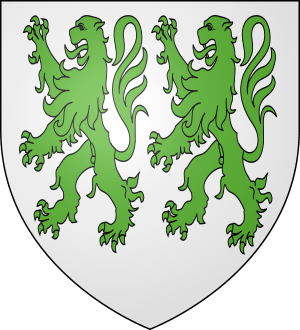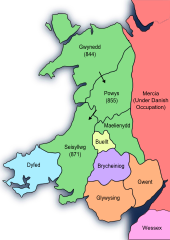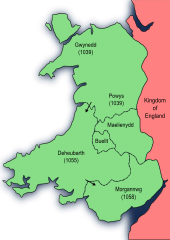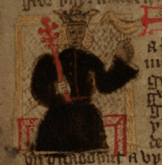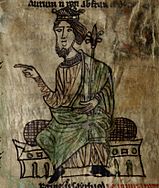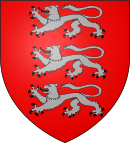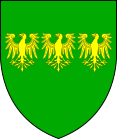King of Wales facts for kids
Quick facts for kids King of Wales |
|
|---|---|
| Brenin Cymru | |
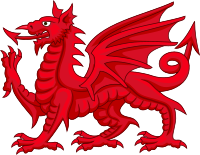
Welsh dragon, Pendragon symbol
|
|
| Details | |
| First monarch | Camber, King of Cambria (Wales) |
| Last monarch | Owain Gwynedd, King of Wales, Prince of Gwynedd |
| Formation | c.1,000 BC |
| Abolition | 1,171 AD |
The title King of Wales (Welsh: Brenin Cymru) has a long history, going back about 3,000 years. It was first used by King Camber around 1,000 BC. He ruled Cambria, which is now Wales, during the European Iron Age.
Camber's family, especially his son Albon, became important leaders. They were known as Governors of North Cambria (North Wales) and Earls of Ewias and Urtchingfild for a thousand years. This lasted until the Roman occupation of Britain.
Later, during the Middle Ages, most Kings of Wales came from the Kingdom of Gwynedd. Many were from the House of Aberffraw. The title of Prince of Wales became more common after the Norman invasion of Wales around 1300 AD.
The Kingdom of Cambria (Wales) was once a smaller part of the Kingdom of Britain. It began with Celtic people who settled in Wales and the British Isles during the late Bronze Age. The first Celts arrived around 1,000 BC. More followed between 500 BC and 200 BC. These Celtic Britons helped create the countries of Great Britain: Wales, England, and Scotland. They were divided into smaller kingdoms based on tribal areas before the Romans arrived.
The title "King of Wales" was not used very often. This is because Wales, like Ireland, was rarely fully united. It was not like England or Scotland during the Middle Ages. Many leaders claimed the title, but only Gruffydd ap Llywelyn truly united Wales. He ruled as Prince of Wales from 1055 to 1063.
Some people believe Rhodri Mawr was the first true ruler of Wales. He was the first to unite most of the country. By the 11th century, the title "Prince of Wales" was used more often.
Contents
History of the Kingdom of Wales
The Welsh Kingdoms that formed after the Romans left (around 400s AD) have Celtic roots. The first Celtic people settled in the British Isles around 1,000 BC.
Welsh Celtic Origins
During the late Bronze Age or early Iron Age (around 800 BC), Cambria (Wales) was divided into four main tribes. These were the Ordovices (Mid to North Wales & Anglesey), the Deceangli (North East Wales), the Silures (South East Wales), and the Demetae (South West Wales).
A second wave of Celtic tribes arrived from Eastern Europe between 500 BC and 200 BC. They built roundhouse settlements. These were often inside or near older hillforts. Roundhouses were used as homes until after the end of Roman rule in Britain. During the Roman time, another Celtic tribe, the Gangani, lived in the Llŷn Peninsula in North West Wales. They had links to Ireland.
Establishing the Kingdom of Cambria (Wales)
A new culture began in pre-Celtic Europe. The mythological first King of Britain, Brutus of Troy, was a Trojan. He was born many generations after the Trojan war (around 1,184 BC). Brutus left Troy (modern-day Turkey) to settle in Great Britain. His ancestor was Prince Aeneas, who was a descendant of Zeus.
Brutus fled the Greek Kingdom and sailed to Totnes, England. A special stone there still remembers his arrival. He defeated Gogmagog the Giant in Britain (Albion). Brutus then founded New Troy, which is now the city of London.
Brutus divided the Kingdoms of Great Britain into three regions for his sons. Locrinus received Loegria (Lloegyr/England). Camber (Kamber) became King of Cambria (Wales). Albanactus received Albania (Scotland). Camber's oldest son, Gorbonian, became a Duke of Cornwall and governor of Cambria. Albon, Camber's second son, became governor of North Cambria and the Earl of Ewias and Urtchingfild.
Brutus' Descendants, Kings of Britain
After the ancient Celtic Kingdom of Cambria (Wales) was founded, Brutus's family grew strong in Britain and Gaul. They ruled for over a thousand years until the Romans arrived. For example, Leir of Britain (who gave his name to Leicester, England) had three daughters. Leir was the last direct male descendant of Brutus of Troy to be King. His life is dated to around 753 BC, when Rome was founded.
Leir's grandson, Cunedagius, later united the Kingdoms of Britain. He ruled Kambria, Lloegyr, and Alba (Wales, England, and Scotland) for 33 years. Many generations later, a descendant of Camber, Prince Dyfnwal Moelmud, wrote the Molmutine Laws for the Kingdom. He was buried in Trinovantum (the original name of London).
The line of British Celtic Kings continued for centuries, from about 500 BC for 700 years. It lasted until the 2nd century AD. Then, Geta, son of the Roman Emperor Septimus Severus, was given the title King of Britain. Geta was also a descendant of Brutus of Troy.
Descendants of Camber, King of Cambria (Wales)
This section lists some rulers of Cambria (Wales) and Britain. It also includes rulers of the combined Kingdoms of Wales (Dyfed, Gwynedd, Powys) and Britain. It starts with King Camber, son of Brutus of Troy, who ruled the Kingdom of Cambria (now Wales). Camber's children shared Cambria. They were Chief Governor of Cambria and Governor of North Cambria. They were also Kings of Britain and Dukes of Cornwall.
List of Chief Governors of Cambria (Wales)
This is a list of descendants of King Camber's oldest son, Gorbonian. They were Chief Governors of Cambria (Wales) and Dukes of Cornwall (legendary).
| Name | Title | Notes | Year | Sources |
|---|---|---|---|---|
| Gorbonian | Duke | Son of Camber; Governor of Cambria & Duke of Cornwall | (c. 1,000BC) | Book of Baglan folios 84, 305 |
| Difnwall Hen | Duke | Son of Gorbonian; Chief Governor of Cambria, Duke of Cornwall | Book of Baglan folios 84, 306 | |
| Kingen | Duke | Son of Difnwall Hen; Governor of Cambria & Duke of Cornwall | Book of Baglan folios 84, 306 | |
| Aser | Duke | Son of Kingen; Governor of Cambria & Duke of Cornwall | Book of Baglan folios 84, 306 | |
| Bledhud (Blaiddyd) | Duke | Son of Aser; Governor of Cambria & Duke of Cornwall | Book of Baglan folios 84, 306; Where Troy Once Stood | |
| Henwin | Duke | Son of Bledhud; Governor of Cambria & Duke of Cornwall; under King Leir; husband of Leir's daughter Regan | 899 BC | Historia Regum Britanniae; Survey of Cornwall; Book of Baglan folios 84, 306 |
| The Chief Governor of Cambria later became the Kings of Britain and Dukes of Cornwall for many centuries. | ||||
List of Chief Governors of North Cambria (North Wales) & Earls
This list shows the descendants of King Camber's second son, Albon. They held the titles of Earl of Ewias and Urtchingfild (Ewyas and Archenfield). They were also Governors of North Cambria (North Wales, UK).
The names Ewias and Urtchingfield are still used today. Ewias comes from the Welsh Kingdom of Ewyas (around the 5th century). This kingdom later became part of the Kingdom of Gwent (South-east Wales). Ewyas Lacy became a Norman hundred (a type of county division). It was ruled by the de Lacy family, who were Welsh marcher Lords. This area is now part of Herefordshire in England. The village Ewyas Harold is on the England–Wales border. Nearby in Wales is the Vale of Ewyas in the Black mountains. Here you can find the ruins of the Llanthony Priory, first built by the De Lacy family around 1100s.
The name Urtchingfield (Irchenfield) is now Archenfield. Irtchingfield was once near a Roman fort called Ariconium. Later, Irchenfield became part of the post-Roman Welsh Kingdom of Ergyng in the early medieval period. Today, Archenfield (Irchenfield) is part of the English county of Herefordshire, also on the Welsh border.
| Name | Title | Notes | Year | Sources |
|---|---|---|---|---|
| Albon | Earl | Governor of North Cambria (North Wales), Earl of Ewias and Urtchingfild, (Earldom of Ewyas & Ergyng) | c. 1,000 BC) | Book of Baglan folios 85-86 |
| Dingad | Earl | Governor of North Cambria, Earl of Ewias and Urtchingfild | Book of Baglan folios 85-86 | |
| Gridion | Earl | Governor of North Cambria, Earl of Ewias and Urtchingfild | Book of Baglan folios 85-86 | |
| Kereint | Earl | Governor of North Cambria, Earl of Ewias and Urtchingfild | Book of Baglan folios 85-86 | |
| Merion | Earl | Governor of North Cambria, Earl of Ewias and Urtchingfild | Book of Baglan folios 85-86 | |
| Arthe | Earl | Governor of North Cambria, Earl of Ewias and Urtchingfild | Book of Baglan folios 85-86 | |
| Keidio | Earl | Governor of North Cambria, Earl of Ewias and Urtchingfild | Book of Baglan folios 85-86 | |
| Keri Hir | Earl | Governor of North Cambria, Earl of Ewias and Urtchingfild | Book of Baglan folios 85-86 | |
| Parar | Earl | Governor of North Cambria, Earl of Ewias and Urtchingfild | Book of Baglan folios 85-86 | |
| Llŷr Lledaeith | Earl | Son-in-law of King of Britain, Beli Mawr (Heli), Governor of North Cambria, Earl of Ewias and Urtchingfild | c. 60 BC | Book of Baglan folios 85-86; Historia Regum Britanniae; Mabinogion; Welsh Triads |
| Bran (the Blessed) | Earl | Son of Llyr, Governor of North Cambria, Earl of Ewias and Urtchingfild, Castell Dinas Bran in Powys his residence. | c. 30 BC | Book of Baglan folios 85-86; Mabinogion; Welsh Triads, 9 |
| Karadowc (Caradog ap Bran) | Earl | Son of Bran, Governor of North Cambria, Earl of Ewias and Urtchingfild. | c. 5 AD | Book of Baglan folios 85-86; Mabinogion; Book of Llandaff; Welsh Triads |
| Endhaf (Eudaf Hen, Octauian / Octavius) | King, Earl. | King of Britain, Governor of North Cambria, Earl of Ewias and Urtchingfild, living near Segontium, Caernarfon, North Wales. | Book of Baglan folios 85-86; Mabinogion; Book of Llandaff; Historia Regum Britanniae | |
| Kenan | Earl | Governor of North Cambria, Earl of Ewias and Urtchingfild | Book of Baglan folios 85-86 | |
| Elen | Saint | Daughter of Eudaf Hen, cousin of Conan King of Cornwall (ancestor of Cunedda, founder of Gwynedd) married Roman King of Britain Magnus Maximus. | c. 4th century | Book of Baglan folios 85-86; Historia Regum Britanniae; Mabinogion; Book of Llandaff; Welsh Triads, 5 |
| The rule of North Cambria and the title of Earl of Ewias and Urtchingfilde ended during the Roman occupation. | ||||
Kings of Welsh Kingdoms as King of Britain
After the Romans left, the Kings of Welsh Kingdoms were sometimes called "King of Britain." This happened for a few centuries before the title "King of Wales" became common. These kingdoms appeared in the 5th century. They took over from the Roman Provinces, which had been there for almost 400 years.
The descendants of both the Chief Governor of Cambria and Governor of North Wales families married each other. They became ancestors of the King of Wales. The Kings of Britain who also ruled Welsh Kingdoms in sub-Roman Britain started with Vortigern. He founded the Kingdom of Powys. Vortigern was the son-in-law of the Roman Emperor and King of Britain, Magnus Maximus (Welsh: Macsen Wledig). Through his wife's family, Magnus Maximus was a descendant of the Governors of North Cambria (Wales). This was written on the Pillar of Eliseg in the 9th century.
| Name | Title | Notes | Year | Sources |
|---|---|---|---|---|
| Vortigern | King | Founder of the Kingdom of Powys, King of Britain. Son-in-law to Roman Emperor, Magnus Maximus | c.420s AD | Historia Regum Britanniae; Welsh Triads, 5 |
| King Arthur | King | Overlord of Wales | c. 500 AD | Historia Regum Britanniae'; Welsh Triads |
| Vortiporius | King | King of Dyfed, King of Britain | c. 500 AD | Historia Regum Britanniae |
| Maelgwn Gwynedd | King | King of Britain, Gwynedd, Descendant of Cunedda of Gwynedd | c.520 AD, King of Britain, King of Gwynedd. | Historia Regum Britanniae; Welsh Triads |
| Selyf ap Cynan | King | King of Powys, King of the Britons | c. 616 AD | Annals of Ulster |
| Idris ap Gwyddno (Idris Gawr) | King | King of the Britons (in 635), King of Meirionnydd | ?–635 | Annals of Ulster (sub anno 633) |
| Cadfan ap Iago | King | Great-great-grandson of Maelgwn, King of Britain, King of Gwynedd. | c.600 AD | Historia Regum Britanniae; Welsh Triads, 8, 48, 52 |
| Cadwallon ap Cadfan | King | Son of Cadfan, King of Britain, King of Gwynedd. | d.634 AD | Historia Regum Britanniae; Welsh Triads |
| Cadwaladr | King | Son of Cadwallon, King of Britain, King of Gwynedd. | d.682 AD | Historia Regum Britanniae; Welsh Triads 12, 43 |
| Rhodri Molwynog | King | King of Britons, Gwynedd, grandson of Cadwladr. Son Cynan Dindaethwy, first ruler of medieval Kingdom of Wales. | d. 754 AD | Annales Cambriae |
| The King of Britain title was later replaced by the medieval Kings of Wales. | ||||
Pendragon
The Celtic Kings of Britain (Latin: Rex Britannorum) sometimes had the title Pendragon. This was similar to the Roman Emperor's title of Caesar. The title began with Uther Pendragon, who was the father of the legendary King Arthur.
The name Pendragon means "a great leader" or "the highest commander." In the Old Welsh language, pen meant "tall hill," "headlands," or "great heights." So, 'pen' (English: Head) can mean a leader. A Dragon is a legendary creature. The term Pendragon came from the Welsh language into Middle English. An example of this title being used was in the 12th century for Rhodri ab Owain Gwynedd, who was the Prince of Gwynedd.
Welsh Post-Roman Kingdoms
Gwynedd
After the 5th century, Wales was united again. It was ruled by the Brythonic Celtic tribes who lived there. The Kingdom of Gwynedd was founded in North West Wales in 401 AD. It was started by Cunedda Wledig, a Roman soldier. He came from Manaw Gododdin (Scotland) to bring peace and stop other Celts from Ireland who were invading.
The rulers of Gwynedd created a kingdom. They were descendants of the last Kings of Britain. During the time of Cadwaladr (the last King of Britain, Prince of Gwynedd, around 660s AD), his family settled in Southwest Anglesey. They supported St Cadwaladr's Church, Llangadwaladr. A Latin inscription in the church still talks about his grandfather, Cadfan ap Iago. It calls him "the Wisest and Most Renowned of All Kings."
Later, King Rhodri Mawr started a new royal family around 870s AD. He built a royal palace at Aberffraw, named after the village. This was the House of Aberffraw on Anglesey, in the Kingdom of Gwynedd.
Early Medieval Use of the Title
When the Roman legions left Wales, the country broke into many smaller areas. Each area had its own leaders. The first person known to call himself "King" was Rhodri Mawr (around 820–878 AD). Since he was from Wales, he was called the King of Wales. However, he did not control the whole country. Still, he united much of the land under his power.
Rhodri died in 878, but his achievements were very important. They inspired future Welsh leaders. This eventually led to the rule of Gruffudd ap Llywelyn (around 1010–1063). He was the first ruler of all of Wales.
Gruffydd ap Llywelyn Rules All Wales
From the smaller kingdoms of Wales, four main powers grew: Powys, Gwynedd, Dyfed/Deheubarth, and Morgannwg. Wales was becoming more united. This set the stage for Gruffudd ap Llywelyn in the mid-11th century. He made alliances with Anglo-Saxon families and Vikings. This helped him unite the country and even conquer land from the English.
In 1055, he also took control of Deheubarth. This made him, in effect, King of Wales. Historian John Davies says that Gruffydd was "the only Welsh king ever to rule over the entire territory of Wales." He adds that "from about 1057 until his death in 1063, the whole of Wales recognised the kingship of and notably peaceful rule by Gruffudd ap Llywelyn. For about seven brief years, Wales was one, under one ruler, a feat with neither precedent nor successor." After his own men betrayed and killed him, Wales fell into civil war. Other leaders then tried to become king.
John of Worcester called Gruffydd ap Llywelyn "King of Wales" or Rex Walensium. He was the last of many important rulers among the Britons to be given the title of King of the Britons. He might have been the only one to truly rule over all the independent Britons. By this time, Wales was the only part of Britain still under Brittonic rule.
List of Medieval "Kings of Wales" Claimants
This is a list of those who were called or claimed the title of King or Prince of Wales. It includes "Sovereigns and Princes of Wales 844–1283." Some sources say Rhodri Mawr was the first ruler of Wales. He was also the first to unite most of Wales. Many leaders in Wales claimed the title "King of Wales." They ruled large parts of Wales. However, the modern-day area of Wales was only fully united under Gruffydd ap Llywelyn for eight years, from 1055 to 1063, according to historian John Davies.
| Depiction | Name & life details | Arms | House, Kingdom | Welsh Titles | Reign | Death & cause | Source |
|---|---|---|---|---|---|---|---|
| Cynan Dindaethwy (Cynan ap Rhodri) | Gwynedd (from 754) |
|
798–816 | Brut y Tywysogion Annals of Ulster Annales Cambriae | |||
| Rhodri the Great (Rhodri ap Merfyn) | Gwynedd, from 855 also Powys, from 872 also Seisyllwg |
|
843 | Brut y Tywysogion Annals of Ulster | |||
| Cadell ap Rhodri | Deheubarh |
|
877 | Brut y Tywysogion | |||
| Anarawd ap Rhodri | Kingdom of Gwynedd |
|
900 | Brut y Tywysogion | |||
| Hywel Dda(Hywel ap Cadell) | Deheubarth (from 920), from 942 also Gwynedd and Powys |
|
942–949/50 | Brut y Tywysogion Annals of Ulster Annales Cambriae | |||
| Aeddan ap Blegywryd | Kingdom of Gwynedd |
|
1000 | Brut y Tywysogion | |||
| Llywelyn ap Seisyll | Gwynedd and Powys; from 1022 also Deheubarth |
|
1023 | Brut y Tywysogion Annals of Ulster | |||
| Gruffydd ap Llywelyn 1010–1063 | Gwynedd and Powys, from 1057 also the rest of Wales |
|
|
The Ulster Chronicle states that he was killed by Cynan in 1064, whose father Iago had been put to death by Gruffydd in 1039. | John of Worcester Annals of Ulster Brut y Tywysogion | ||
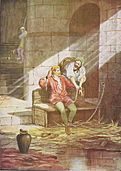 |
Gruffudd ap Cynan 1055–1137 | House of Aberffraw, Gwynedd (from 1081) | House of Aberffraw, Gwynedd (from 1081) |
|
1137 | Died in 1137, aged 81–82. | Brut y Tywysogion |
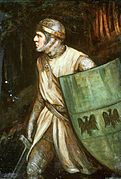 |
Owain Gwynedd 1100 – November 1170 | Caernarfon (Retroactively attributed with no evidence of use.) | Gwynedd |
|
1146–1170 | Died in 1170, aged 69–70. | Brut y Tywysogion; contemporary charters. |
| After this time, only the title Prince of Wales was used. | |||||||
King of the Welsh & Cornwall (Dumnonia)
| Name & title | House, Kingdom | Welsh Titles | Reign | Source |
|---|---|---|---|---|
| Geraint of Dumnonia, King of the Welsh | ?670–c. 710 Dumnonia |
|
710 (battled against by Ine) | Anglo-Saxon Chronicle |
Evolution into Prince of Wales
According to Dr. Sean Davies, Welsh leaders started using the new title of "prince" (Welsh: Tywysog, Latin: Princeps). This was to set them apart from other "kings" when their power was limited. However, the title King of Wales was later used by at least one other Welsh ruler, Owain Gwynedd (around 1100–1170). In his first two letters to Louis, Owain called himself "king of Wales" and "king of the Welsh." But his direct rule was only over Gwynedd.
Owain was also the first Welsh ruler known as Prince of Wales. He ruled much of Northern Wales. But he did not succeed in military campaigns, which limited his control. After Owain Gwynedd died in 1170, Rhys ap Gruffydd (around 1132–1197) became the main Welsh ruler. The Brut y Tywysogion called him "Head of all Wales" when he died in 1197. His direct rule was limited to Deheubarth. For a list of Welsh rulers who held such titles, see King of the Britons.
Llywelyn II
Llywelyn the Last, who was the last Prince of Wales, was attacked and killed in 1282. His brother Dafydd ap Gruffydd was executed in 1283 by King Edward I of England. This effectively ended Welsh independence. After this, the English monarchy used the title Prince of Wales for the heir to the English throne.
Owain Glyndŵr
Between 1400 and 1413, there was a rebellion against English rule in Wales. During this time, there was a native Prince of Wales, Owain Glyndŵr. There was also a Prince of Wales appointed by the English monarchy, who later became Henry V of England.
Glyndwr was a descendant of the last ruling families from the Kingdom of Wales. He was also related to Llywelyn the Great, Prince of Wales, through his mother's side. Glyndwr used guerrilla warfare against the English Crown. He declared himself Prince of Wales in 1400 and ruled for over ten years.
Owain Glyndŵr led Welsh forces against the English Prince of Wales and English rule. He started the Glyndŵr rebellion. He also allied Wales with the Kingdom of France and the King of Scotland. In a letter to Scotland, he talked about their royal ancestor, Brutus of Troy. Brutus was the King of Great Britain who founded the Kingdom of Wales (Cambria). Glyndwr mentioned this in relation to his enemies, the Saxons in England.
The defeat of Glyndwr's forces ended Welsh independence. Since Owain Glyndŵr's death in 1415, the Prince of Wales title has only been held by a non-native heir to the English (and later British) monarchy.
Welsh Manuscripts
Here are some Welsh manuscripts. They were copied or translated from older works, some possibly thousands of years old:
- Book of Llandaff, around 1125.
- Historia Regum Britanniae, around 1136.
- Mabinogion, around the 12th century.
- Welsh Triads (Peniarth Manuscripts / Red Book of Hergest), around the 13th century.
- Brut y Tywysogion, 14th century.
- Book of Baglan, 1600 & 1607.


